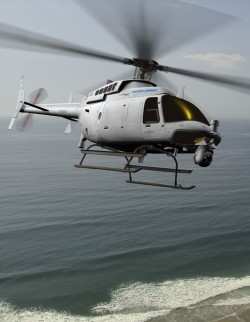Mon, May 10, 2010
Fire-X Increases Payload, Range On Fire Scout Platform
 U.S. war fighters will be able to keep tabs on their enemies
for longer periods of time, communicate more easily with their
commanders, and deliver more cargo to more remote locations using
the new Fire-X medium-range vertical unmanned aerial system (VUAS)
unveiled Wednesday by Northrop Grumman and Bell
Helicopter.
U.S. war fighters will be able to keep tabs on their enemies
for longer periods of time, communicate more easily with their
commanders, and deliver more cargo to more remote locations using
the new Fire-X medium-range vertical unmanned aerial system (VUAS)
unveiled Wednesday by Northrop Grumman and Bell
Helicopter.
The two companies have partnered to develop and demonstrate the
new rugged, high-capacity unmanned aerial system based on the
four-blade, single-engine Bell 407 helicopter. First flight of
Fire-X is expected by the end of 2010. The new system also
represents Northrop Grumman's entry in an anticipated U.S. Navy
competition in 2011 to demonstrate a new medium-range UAS.
"The Fire-X system integrates Northrop Grumman's proven unmanned
systems know-how with a proven, FAA-certified helicopter airframe
that's been in service since 1996," said Gene Fraser, sector vice
president and general manager for the Advanced Programs and
Technology division of Northrop Grumman's Aerospace Systems sector.
"The result will be an affordable, fast-fielding system that
delivers the maturity of the unmanned systems architecture
developed by the U.S. Navy's MQ-8B Fire Scout program, while giving
military services the extra UAS cargo, payload and endurance they
seek."
 Reporters got their first look at the new VUAS concept in
Northrop Grumman's booth at the Navy League Sea-Air-Space
Exposition in National Harbor, MD. "Bell Helicopter brings to the
Fire-X development more than 50 years of experience producing and
supporting U.S. military helicopters across the full rotary-wing
aviation mission spectrum, including armed reconnaissance, attack,
utility, and MedEvac," said Jeff Lowinger, executive vice president
of engineering for Bell Helicopter. "We're also backing this new
offering with Bell's unmatched global logistics support, training,
and industry-leading customer service."
Reporters got their first look at the new VUAS concept in
Northrop Grumman's booth at the Navy League Sea-Air-Space
Exposition in National Harbor, MD. "Bell Helicopter brings to the
Fire-X development more than 50 years of experience producing and
supporting U.S. military helicopters across the full rotary-wing
aviation mission spectrum, including armed reconnaissance, attack,
utility, and MedEvac," said Jeff Lowinger, executive vice president
of engineering for Bell Helicopter. "We're also backing this new
offering with Bell's unmatched global logistics support, training,
and industry-leading customer service."
 Fire-X will incorporate Fire Scout's modular, field-proven
architecture that accommodates a variety of intelligence,
surveillance and reconnaissance (ISR) and communications payloads.
It also provides complementary capabilities for missions that
demand larger payloads (up to 3000 pounds), longer endurance (more
than 14 hours) and robust cargo hauling (up to 2646 pounds
external).
Fire-X will incorporate Fire Scout's modular, field-proven
architecture that accommodates a variety of intelligence,
surveillance and reconnaissance (ISR) and communications payloads.
It also provides complementary capabilities for missions that
demand larger payloads (up to 3000 pounds), longer endurance (more
than 14 hours) and robust cargo hauling (up to 2646 pounds
external).
The aircraft is being designed to operate with nearly any type of
current or future military standards-based control segment. It will
communicate as easily with shipboard controllers using the Navy's
Tactical Control Station (TCS) as field commanders using the U.S.
Army's field-proven One System® ground control station. It also
takes full advantage of Northrop Grumman's proven ability to
"unman" or optionally man a manned helicopter – i.e. replace
the in-vehicle pilot with the appropriate avionics, software and
ground control station to accurately and reliably duplicate the
behavior and performance of the air vehicle.
More News
He Attempted To Restart The Engine Three Times. On The Third Restart Attempt, He Noticed That Flames Were Coming Out From The Right Wing Near The Fuel Cap Analysis: The pilot repor>[...]
Make Sure You NEVER Miss A New Story From Aero-News Network Do you ever feel like you never see posts from a certain person or page on Facebook or Instagram? Here’s how you c>[...]
From 2009 (YouTube Edition): Leading Air Show Performers Give Their Best Advice for Newcomers On December 6th through December 9th, the Paris Las Vegas Hotel hosted over 1,500 air >[...]
Aero Linx: NASA ASRS ASRS captures confidential reports, analyzes the resulting aviation safety data, and disseminates vital information to the aviation community. The ASRS is an i>[...]
“For our inaugural Pylon Racing Seminar in Roswell, we were thrilled to certify 60 pilots across our six closed-course pylon race classes. Not only did this year’s PRS >[...]
 NTSB Final Report: Rutan Long-EZ
NTSB Final Report: Rutan Long-EZ ANN FAQ: Turn On Post Notifications
ANN FAQ: Turn On Post Notifications Classic Aero-TV: ICAS Perspectives - Advice for New Air Show Performers
Classic Aero-TV: ICAS Perspectives - Advice for New Air Show Performers ANN's Daily Aero-Linx (06.28.25)
ANN's Daily Aero-Linx (06.28.25) Aero-News: Quote of the Day (06.28.25)
Aero-News: Quote of the Day (06.28.25)





